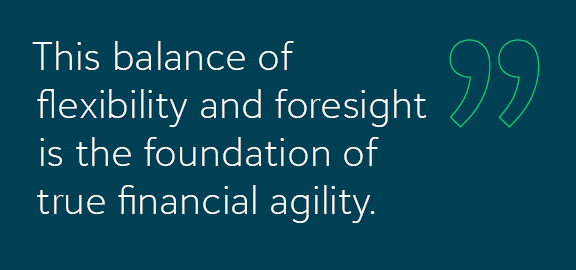The Importance of Financial Agility in K–12 Private Schools (and How to Get It)

As part of the leadership of a K–12 private school, it often feels like you are the captain of a ship navigating through unpredictable waters. Some days, the seas are calm, and the destination is clear. Other days, sudden storms like economic shifts, enrollment fluctuations, and policy changes can emerge like unexpected squalls, threatening to disrupt your school’s stability.
To steer your institution safely through these challenges, you need more than just a steady hand. You need the ability to adapt quickly and effectively. That’s where financial agility comes into play. Modern K–12 private schools require a new level of financial responsiveness to address changing conditions while continuing to prioritize student success. Let’s explore why this agility is so essential and how your school can achieve it.
Key Trends Shaping the Financial Landscape for K-12 Private Schools
Private K–12 schools operate within a dynamic financial landscape shaped by external factors that can shift unexpectedly. Enrollment changes, driven by demographic trends and shifting family preferences, often play a significant role in determining your school’s revenue. Declining birth rates and aging populations in certain regions may result in fewer prospective students, while other areas could see an uptick in demand due to population growth or increased interest in private education. Monitoring these trends helps you anticipate how enrollment will impact your finances.
Policy changes also affect your school’s bottom line. Government initiatives, tax incentives, or voucher programs can increase accessibility to private education, spurring enrollment growth. Conversely, new regulations may require costly compliance measures or create barriers for families considering private schooling. Staying informed about legislative developments ensures your school can adapt without losing focus on delivering quality education.
Weather-related events, unfortunately, have become more frequent and unpredictable. Severe storms or natural disasters can disrupt school operations, reduce event-based revenue, or necessitate costly repairs. Proactive planning, including allocating funds for emergency preparedness, can help minimize the financial strain these events cause.
Finally, shifts in federal funding have wide-ranging effects on private schools, especially those providing specialized programs or Individualized Education Plan (IEP) resources. Cuts to funding streams or changes in eligibility criteria may force schools to reallocate resources or identify alternative revenue sources to sustain these offerings.
Your school faces a complex array of pressures that influence both revenue and expenses. Identifying and forecasting these trends can empower you to respond effectively while keeping student education at the heart of every financial decision.
Why Financial Agility is Key for K–12 Private Schools
To engage with these financial complexities, private K–12 schools must adopt a strategy of financial agility—an approach that blends revenue diversity, operating reserves, and precise financial reporting. These components provide the flexibility and insight needed to anticipate and adapt to changes while prioritizing student success.
Revenue Diversity: Strength in Variety
Relying heavily on a single income stream, such as tuition, can leave your school vulnerable to unexpected fluctuations. For instance, an enrollment dip or an external event impacting tuition payments could significantly disrupt operations. By diversifying your revenue streams, you create a financial safety net that ensures stability even when one area experiences a downturn.
A healthy mix of income sources—such as fundraising, endowments, grants, and program-specific fees—helps reduce reliance on any single contributor. Balancing restricted funding (earmarked for specific purposes) with unrestricted funding (flexible use) ensures you have both targeted resources and adaptable funds to address immediate needs. Regularly evaluating your revenue streams and their returns on investment can help you identify where to focus your efforts for sustainable growth.
Operating Reserves: Breathing Room for Strategic Decisions
Operating reserves are essential for weathering short-term financial disruptions and taking advantage of opportunities that arise. Think of reserves as your school’s financial buffer—enabling you to handle an unplanned repair, respond to a sudden enrollment change, or invest in a promising initiative without compromising daily operations.
By maintaining well-funded reserves and aligning them with your school’s spending policy, you ensure that financial decisions remain deliberate, rather than reactive. This breathing room allows leadership teams to focus on long-term goals while maintaining stability in the face of short-term challenges.
Current and Accurate Reporting: Your Financial Compass
Effective financial agility isn’t possible without personalized and accurate reporting. A single source of truth for your school’s financial data eliminates confusion and keeps all stakeholders—CFOs, Heads of School, board members, and others—aligned in their decision-making.
Advanced reporting tools that integrate scenario planning, forecasting, and cash flow management allow you to pinpoint potential gaps, project outcomes, and create proactive solutions. With access to real-time data, your school can adapt to changing conditions more effectively and make well-informed financial choices.
By implementing these practices, your school not only strengthens its ability to adapt but also reinforces its commitment to delivering quality education no matter the financial climate. This balance of flexibility and foresight is the foundation of true financial agility.

How Your School Can Be More Financially Agile
Financial agility doesn’t happen overnight—it requires intentional planning and the right systems to support it. Here’s how your school can build flexibility and sustainability to navigate challenges effectively:
Strengthen Your Operating Reserves
Operating reserves act as your school’s financial safety net, providing stability during unexpected disruptions or opportunities. Begin by defining a reserve policy aligned with your long-term goals to make sure reserves are maintained and used thoughtfully. Regularly review and update the policy to reflect current priorities and allocate funds strategically to balance day-to-day operations with future planning.
Diversify Revenue Streams
Relying solely on tuition revenue can be risky. Collaborate with your development team and leadership staff to explore additional income sources, such as fundraising campaigns, grant opportunities, or fee-based programs. Evaluate each revenue stream’s return on investment—including time and resources required—to prioritize efforts that deliver the greatest impact. A diverse financial portfolio helps mitigate risk and maintain stability during economic shifts or enrollment changes.
Develop a Cash Flow Plan
A clear cash flow plan ensures consistency and allows for better forecasting. By analyzing historical trends and anticipating future fluctuations, you can allocate resources more effectively. A strong plan provides insights into timing gaps between income and expenses, enabling your school to adjust proactively rather than reactively.
Create a Unified Reporting System
Accurate and timely financial data is crucial for informed decision-making. Integrate automated systems that eliminate manual entry errors and provide access to real-time information, creating a single source of truth for your school’s financial health. This unified reporting system allows leadership to quickly identify trends, address gaps, and implement actionable solutions with confidence.
Implementing these strategies empowers your school to adapt quickly, sustain operations, and continue delivering quality education, no matter the financial challenges ahead.
Unlock Financial Agility with the Right Tools
A fund accounting system like Blackbaud Financial Edge NXT® can be instrumental in helping private K–12 schools achieve financial agility. By offering specialized tools designed for nonprofit financial management, Financial Edge NXT allows schools to manage their finances with greater precision, adaptability, and foresight.
When integrated with Blackbaud Tuition Management™ and Blackbaud Raiser’s Edge NXT®, Financial Edge NXT becomes even more powerful. It creates a seamless connection between tuition revenue tracking, billing operations, fundraising, and overall financial reporting. This integration reduces manual work, minimizes errors, and provides leadership with accurate, real-time data to make informed decisions.
For schools aiming to diversify revenue streams, Financial Edge NXT offers advanced reporting capabilities that help evaluate the effectiveness of each source—whether it’s tuition, fundraising, or grants. This level of insight enables schools to prioritize initiatives and optimize efforts for sustained growth.
Additionally, the software’s forecasting and cash flow management tools empower schools to plan with confidence. By identifying trends, gaps, and opportunities, leadership teams can proactively allocate resources and prepare for changes in enrollment or external funding. The ability to create scenario-based plans ensures that schools are equipped to navigate financial challenges while maintaining their commitment to student success.
Financial Edge NXT is a practical solution for schools looking to enhance their financial agility. It provides the tools needed to manage reserves effectively, diversify income, and maintain clarity in reporting—all essential components for staying adaptable in a shifting financial landscape.
Discover how fund accounting software can help private K–12 schools navigate enrollment shifts, policy changes, and unexpected challenges by checking out our white paper, Why K–12 Schools Need Fund Accounting Software.


